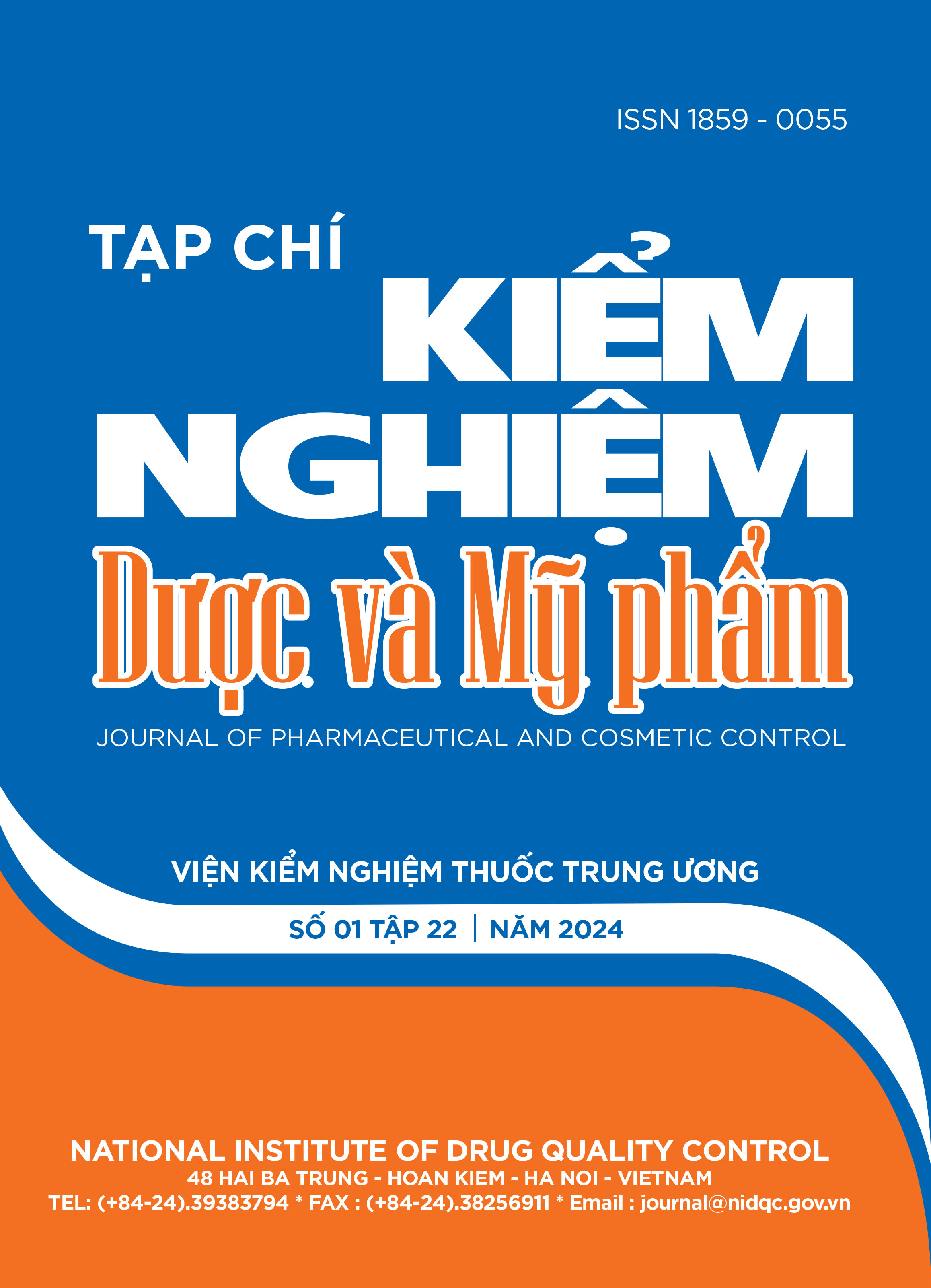Quantitative determination of aconitine in aconite root and black-processed aconite by hplc method
Main Article Content
Abstract
The procedure for quantifying aconitine in Fuzi and Black-processed aconite using the HPLC method has been successfully developed. The chromatographic conditions include an Agilent 1260 Infinity II HPLC system with a PDA detector, a Phenomenex C18 column (250 × 4.6 mm; 5 µm, USA), a flow rate of 1.0 mL/min, a sample injection volume of 20 μL, and chromatography performed at room temperature (25 ± 5 °C). The aconitine elution process is carried out according to a gradient program with a mobile phase system consisting of acetonitrile and a buffer solution containing 0.2 % glacial acetic acid, with the pH adjusted to 6.20 ± 0.05 using triethylamine. The quantification procedure has been validated to meet the requirements for system suitability, specificity, linearity, repeatability, intermediate precision, and accuracy. Quantitative results showed that Black-processed aconite has an aconitine content reduced by 4.5 times compared to Fuzi.
Article Details
Keywords
Aconite root, black-processed aconite, aconitine, HPLC
References
2. G. He, X. Wang, W. Liu, Y. Li, Y. Shao, W. Liu, X. Liang, X. Bao (2023), Chemical constituents, pharmacological effects, toxicology, processing and compatibility of Fuzi (lateral root of Aconitum carmichaelii Debx): A review, J Ethnopharmacol, 307, e116160.
3. M. Wang, W. J. Hu, X. Zhou, K. Yu, Y. Wang, B. Y. Yang, H. X. Kuang (2023), Ethnopharmacological use, pharmacology,
toxicology, phytochemistry, and progress in Chinese crude drug processing of the lateral root of Aconitum carmichaelii Debeaux. (Fuzi): A review, J Ethnopharmacol, 301, e115838.
4. Y. Gao, H. Fan, A. Nie, K. Yang, H. Xing, Z. Gao, L. Yang, Z. Wang, L. Zhang (2022), Aconitine: A review of its pharmacokinetics, pharmacology, toxicology and detoxification, J Ethnopharmacol, 293, e115270.
5. T. Y. Chan (2009), Aconite poisoning, Clin Toxicol (Phila), 47(4), pp.279-285.
6. X. L. Xu, L. J. Yang, J. G. Jiang (2016), Renal toxic ingredients and their toxicology from traditional Chinese medicine, Expert Opin Drug Metab Toxicol, 12(2), pp.149-159.
7. Bộ Y tế (2017), Hướng dẫn phương pháp chế biến các vị thuốc cổ truyền. Thông tư số 30/2017/TT-BYT, Hà Nội, tr.86-87.
8. Bộ Y tế (2017), Dược điển Việt Nam V. Ban hành kèm theo Quyết định số 5358/QĐ-BYT, Hà Nội, tr.1291-1292.
9. P. Y. Chou, C. C. Wang, C. J. Tai, T. L. Yang, Y. J. Tang (2018), Bradycardia and Hypotension from Improper Use of Aconite Root: A Case Report and Brief Review, Complement Med Res, 25(5), pp.338-343.
10. Nguyễn Văn Đàn, Phan Châu Quyền, Nguyễn Thị Thành, Lê Thị Lan Hương (2023), Báo cáo ca lâm sàng: Ngộ độc Phụ tử, Tạp chí Y học cộng đồng, 64(8), tr.226-231.
11. Hong Kong Chinese Materia Medica Standards Volume 2 (2008), Appendix XIV: Detection of Aconitine, Hypaconitine and Mesaconitine, Department of Health Hong Kong Special Administrative Region, The People’s Republic of China.
12. Ministry of Health of the People’s Republic of China (2020), The Pharmacopoeia of the People’s Republic of China, Part I: The Pharmacopoeia Commission of PRC, Beijing: China Medical Science Press.
13. ICH Harmonised Tripartite Guideline (2022),Validation of Analytical Procedures Q2(R2)International Council for Harmonisation of Technical Requirements for Pharmaceuticals for Human Use, Geneva, Switzerland.
14. AOAC Official Methods of Analysis (19th Ed.) (2016), Appendix F: Guidelines for Standard Method Performance Requirements, AOAC INTERNATIONAL, Gaithersburg.
15. Đỗ Tất Lợi (2004), Những cây thuốc và vị thuốc Việt Nam, Nhà xuất bản Y học, tr.876-882.
16. L. Tang, Y. Gong, C. Lv, L. Ye, L. Liu, Z. Liu (2012), Pharmacokinetics of aconitine as the targeted marker of Fuzi (Aconitum carmichaeli) following single and multiple oral administrations of Fuzi extracts in rat by UPLC/MS/MS, J Ethnopharmacol, 141(2), pp.736-741.
17. P. Tong P, C. Wu, X. Wang, H. Hu, H. Jin, C. Li, Y. Zhu, L. Shan, L. Xiao (2013), Development and assessment of a completedetoxication strategy for Fuzi (lateral root of Aconitum carmichaeli) and its application in rheumatoid arthritis therapy, J Ethnopharmacol, 146(2), pp.562-571.


